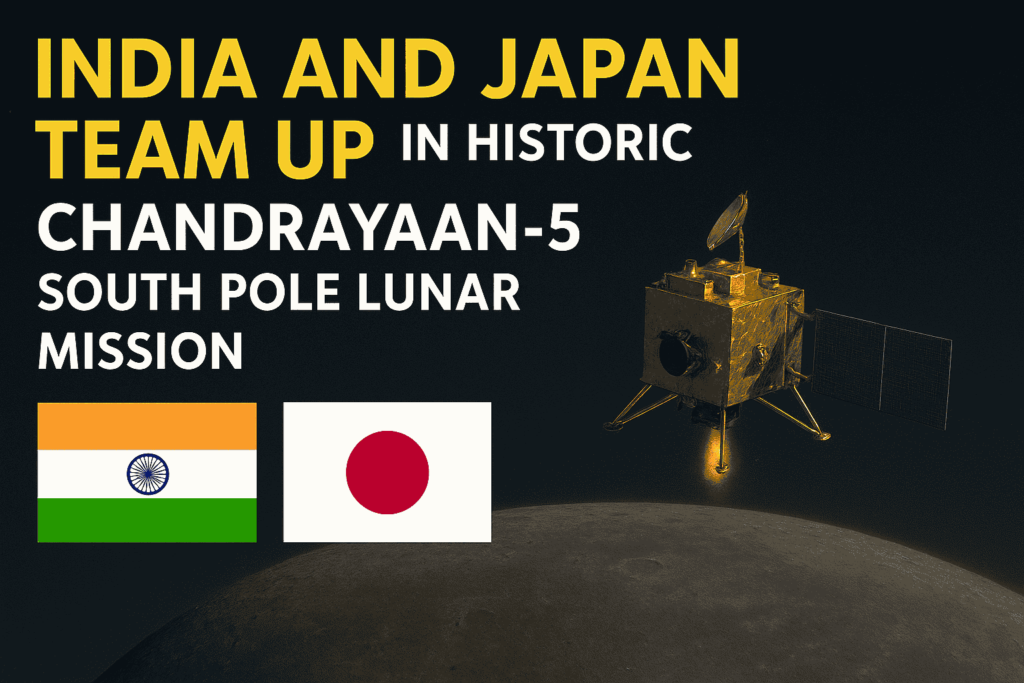🚀 India and Japan Team Up for Chandrayaan-5 Mission to Explore Moon’s South Pole:
🌍 India and Japan Team Up for Chandrayaan-5: A New Era of Lunar Exploration
In a historic move, India and Japan team up for the Chandrayaan-5 mission, a joint effort by the Indian Space Research Organisation (ISRO) and the Japan Aerospace Exploration Agency (JAXA) to explore the Moon’s south pole.
The agreement, signed during the 15th India-Japan Annual Summit in New Delhi, gives practical shape to the Lunar Polar Exploration Mission (LUPEX). The mission’s primary objective is to study volatile elements on the Moon, including water ice hidden in permanently shadowed regions of the lunar surface.

🚀 India and Japan Team Up: Mission Details on What Chandrayaan-5 Will Do
The Chandrayaan-5 will be launched using Japan’s H3-24L launch vehicle.
ISRO will provide the lunar lander, while JAXA will contribute a sophisticated lunar rover.
Together, the rover and lander will conduct in-situ analysis of lunar volatiles, with a special focus on water molecules.
This collaboration is seen as a big leap in Indo-Japanese space partnership, taking forward the success of Chandrayaan-3’s historic landing on the lunar south pole in 2023.
🗨️ Leaders’ Reactions:
Speaking at the summit, Prime Minister Narendra Modi said:
“I am glad that India and Japan Team Up for the Chandrayaan-5 or LUPEX mission. This will deepen our understanding of the Moon’s south pole and help humanity unlock future space opportunities.”
Japan’s Prime Minister Shigeru Ishiba echoed this sentiment, stating that the mission would strengthen technological cooperation and pave the way for resource-driven space exploration.
🌌 Why the Moon’s South Pole Matters:
The lunar south pole has become a key target for global space missions. The presence of water ice in permanently shadowed craters could hold the key to:
Supporting future human settlements on the Moon
Providing fuel and oxygen for deep space exploration
Expanding our scientific understanding of lunar geology
By joining forces, India and Japan Team Up to place themselves at the forefront of this new space race.
🔑 Key Highlights:
✅ India and Japan team up for the Chandrayaan-5 LUPEX mission
✅ Launch planned onboard Japan’s H3-24L rocket
✅ ISRO developing the lander; JAXA building the rover
✅ Mission to study water ice and volatile materials at the Moon’s south pole
✅ Strengthens Indo-Japan partnership in space exploration
📢 Stay Updated with Digital Preeyam News – Latest World News:
For more insights on space exploration, science, and technology breakthroughs, follow Digital Preeyam News – World News Section.
✅ Breaking space and science updates
✅ Expert insights on ISRO, NASA, and JAXA missions
✅ In-depth analysis of global space trends
👉 Subscribe now to Digital Preeyam News and never miss an update.
Social Media Profile:
❓ Frequently Asked Questions (FAQs) - on India and Japan Team Up for Chandrayaan-5:
Q1. What is the Chandrayaan-5 mission?
Answer: Chandrayaan-5 is India’s upcoming lunar exploration mission focused on studying the Moon’s South Pole. It is a collaboration between the Indian Space Research Organisation (ISRO) and Japan Aerospace Exploration Agency (JAXA).
Q2. Why are India and Japan teaming up for Chandrayaan-5?
Answer: India and Japan are teaming up to combine ISRO’s expertise in lunar missions with JAXA’s advanced space technology. The partnership aims to enhance scientific research and explore new areas of the Moon that remain untouched.
Q3. What will Chandrayaan-5 explore on the Moon?
Answer: The mission will primarily focus on the Moon’s South Pole to study water ice, surface composition, and other resources that can support future space exploration.
Q4. How will Japan contribute to Chandrayaan-5?
Answer: JAXA will provide advanced rover technology, instruments for surface analysis, and support in mission planning, making the mission stronger and more reliable.
Q5. When is Chandrayaan-5 expected to launch?
Answer: While the official launch date has not been announced, Chandrayaan-5 is expected to launch in the late 2020s as per current planning stages.
Q6. What makes the Moon’s South Pole important for Chandrayaan-5?
Answer: The South Pole of the Moon contains permanently shadowed regions that may hold significant amounts of frozen water and valuable resources, making it crucial for future lunar bases and human missions.
Q7. How will Chandrayaan-5 benefit future space exploration?
Answer: The mission will help unlock resources for long-term space travel, provide key insights into lunar geology, and strengthen global cooperation in space research between India and Japan.

















